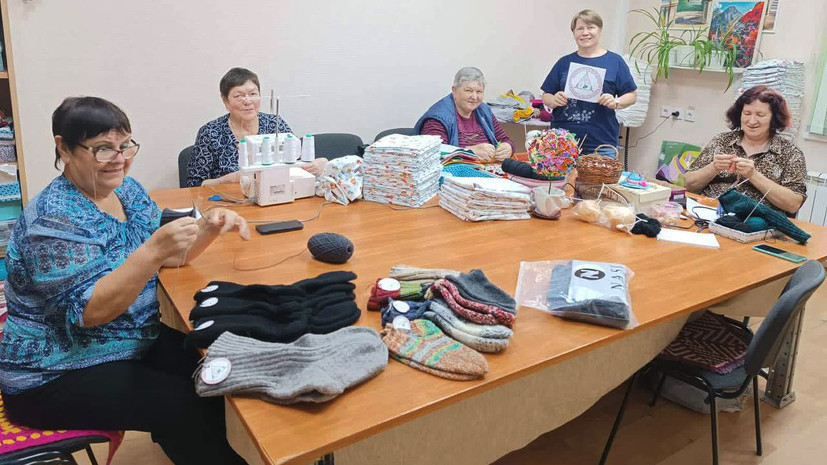Two years ago, the administration of the city of Makeyevka turned to volunteers from the Khanty-Mansi Autonomous Okrug for help: they were asked to send 1.1 thousand sets of textiles for Donbass families with babies under one year of age. In addition, there was a request for bed linen from children’s medical organizations in the region, recalls the founder of the non-profit organization “Satellite Social Service Center” Irina Vladimirova, who participated in that meeting.
In a short time, she assembled a group of 12 local seamstresses. The first workshop opened in the village of Russkinskaya. “We sewed diapers, towels, bed linen, blankets and sent them to Makeevka. In addition, we managed to cover the needs of Stakhanov and Lugansk,” recalls Irina. — Since the order volumes are very large, we had to look for a source of financing. We managed to receive two grants for a total of 2.5 million rubles. These funds were used to purchase fabrics and threads.”
Production ceased to be located in one workshop, and after four months three branches were opened in populated areas of the Surgut region. If initially the team had 12 “silver” volunteers, now 86 elderly seamstresses are involved in the project.
Over time, younger volunteers began to join them. Senior mentors willingly help them master the basics of cutting and sewing. For example, some volunteers in the urban village of Bely Yar knew how to sew on sewing machines, but had never worked on an overlocker. A professional seamstress helped them master this technique for processing sections, about whom her colleagues speak with great gratitude. However, even those who had never worked with sewing equipment helped to cut, fold, iron and perform other important manipulations.
© Photo from personal archive
“The volunteers encouraged each other, changed when someone got tired, no one complained or demanded a reward. After all, the best reward is helping others and feeling needed!” — one of the project participants responds.
“Everyone has been sewing since they were young”
Most needlewomen began sewing in childhood. “At first I sewed clothes for dolls, and during school craft lessons I made something for myself. From the age of 15, I was already sewing fur hats, coats, and rabbit fur coats, not to mention lighter clothes. I only wore my own, exclusive ones,” 65-year-old Tamara Bakharevskaya, a volunteer at a volunteer sewing workshop in Bely Yar, shares with RT. — In the 1990s, after receiving a specialty in civil engineering, I retrained and sewed stage costumes until retirement. I learned about the opportunity to help and now I enjoy sewing at home. I have cars, so I spend my evenings doing what I love.”
© Photo from personal archive
Another participant in the project from Bely Yar, 52-year-old Tatyana Chudnova, made her first confident stitch at school. “As a teenager, I altered dresses, skirts, blouses, and mastered the foot-operated sewing machine. Sometimes it worked out very well,” recalls RT’s interlocutor. — In the first year of pedagogical school, we bought fabrics and sewed our own uniforms. The firstborn was born in the early 1990s, when it was difficult to find in stores not only clothes for babies, but also simple diapers. That’s when I mastered other types of sewing skills, and even took specialized courses. My experience was useful this time too.”
“When I was four years old, we had a makeshift dressing room in our house. And on the very top shelf my mother kept rolls of fabric. I always loved hiding there and dreamed of being a dressmaker for my dolls. One day I cut out pieces of fabric almost from the middle of the cuts and sewed dresses for my Veronica. Mom didn't scold me. Instead, she gave me books on cutting and sewing,” 40-year-old project coordinator Albina Shukshina recalls her first steps in the sewing business.
But Marina Chudaykina sewed the dolls themselves: “I sewed one of my first dolls—an ostrich—as a gift for my class teacher. In our Lyantor group, everyone has been sewing mainly since they were young. People responded to our recruitment ad: “We’ll be happy to help, it’s our duty.”
In the city of Lyantor, not only adults, but also children take part in the project. “For example, at Lyantorskaya School No. 5 there was a volunteer sewing workshop producing bed linen for children’s hospitals. Children also draw tags and postcards, and we put them in our products,” explained Irina Vladimirova.
© Photo from personal archive
According to her, the team sewed more than 1.1 thousand sets of textiles for families with babies in Makeevka, Stakhanov and Lugansk, and also sent new diapers, towels and bed linen to five children's hospitals in Makeevka. During their work, volunteers received requests not only for children’s textiles, so the project team also began collecting humanitarian aid. “In two years we sent more than 3 tons of humanitarian aid,” recalls Irina.
Participants in the project, and there are now about 300 of them, send to Donbass woolen socks knitted with their own hands, food, school supplies, medicines, small household appliances - “everything that is needed and that we managed to collect,” summarizes Vladimirova. They also collect clothing, new and used. In the latter case, it is washed, ironed, if necessary, professionally repaired, and buttons are sewn on.
This year the grant issued for the project expires, but volunteers from Khanty-Mansi Autonomous Okrug will continue their work. “We are looking for additional opportunities for this. The need remains, and children's hospitals still need help, including ours. We will fight for victory as best we can,” summed up Irina Vladimirova.

